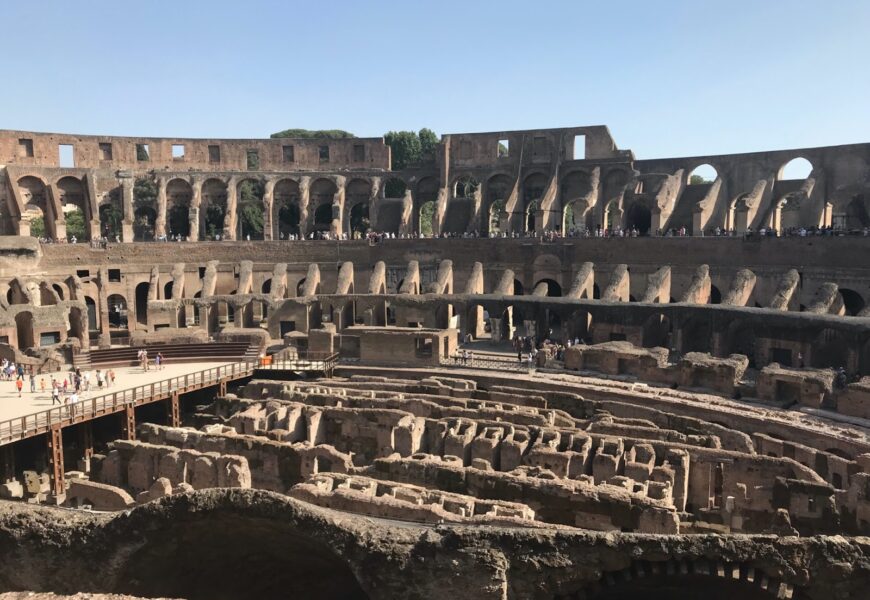Courtesy of Gracie Mattaliano ‘25
Imagine this: you’re sitting at a table with your friends, doing a puzzle…except the puzzle just happens to be an ancient Grecian vase. This is exactly what sophomore Gracie Mattaliano experienced as part of her summer Art History trip. The group of Connecticut College students pieced together fragments of Grecian pottery with duct tape until they had recreated a vase, sans a few missing pieces.
This past summer, on the department’s first trip since 2019, students across disciplines with an interest in Art History and conservation joined Professor Joseph Alchermes on a trip to Italy and Greece through the Archaeological Conservation Institute. The trip, which began in 2015, runs annually from mid-June to mid-July, hosting up to 15 students on an exploration of the mechanics, importance, and application of art conversation in renowned archeological sites.
This year’s group consisted of 15 students, ranging from rising sophomores to just graduated seniors, across majors such as Art, Art history, Classics, and Architecture. The students began their experience staying in a monastic complex in Belmonte in Sabina, Italy. A product of a conservation project itself, the monastery is a reformed complex now used as a facility to teach and execute art conservation by some of the world’s leading conservators. The group was hosted by husband and wife Roberto Nardi and Andreina Costanzi Cobau, who Alchermes described as “committed to highlighting and nurturing an appreciation of Roman and Mediterranean cultures.” For the duration of their trip, the students were accompanied by instructor Manuel Giandomenico, graduate of L’Istituto Centrale per il Resturo, who helped them navigate conservation and the trip as a whole.
During their first few days, the students spent their time learning about the fundamentals of art conservation from leading archeologists and conservators. Instructors from Il Centro di Conservazione Archeologica, one of Italy’s lead companies in conservation, taught terminology, techniques, classification methods, and more. The students also took part in their first field work experience, working on cleaning and restoring an old villa in Cottanello, filled with mosaics and intricate designs.
While working on the villa gave the group their first glimpse of conservation, the majority of their experiences in the field happened in Greece. Mattaliano said the Greece portion of the trip was her personal favorite, as it provided opportunities for hands-on work and the application of what they learned the week prior in Italy. The students worked on the conservation of Ancient Corinth, restoring a centaur mosaic. They carefully cleaned the mosaic, documenting any pieces that came loose, placing volcanic rocks on top of the tiles to prevent them from moving during their work.
In addition to this restoration project, the group had the chance to visit other important archaeological sites, including the Acropolis, Athens, Epidaurus, Nafplion, and a variety of medieval castles. The group also worked on smaller projects, such as the aforementioned piecing together of pottery fragments or removing prior unsuccessful conservation attempts from a stone plaque. Mattaliano reflected on how conservation is about making sure the piece still conveys the artist’s true meaning–restoration is important, but holes or incomplete pieces are sometimes better left as such to avoid changing the pieces’ meanings.Through all of their work, the group truly got to experience the importance of conservation and creating a bridge between history and the present.
After finishing their time in Greece, the group made it back to Rome after their anticipated quick plane ride turned into a train ride, ferry ride, and another train ride — an adventure which Alcheremes refers to as the group’s own odyssey. There, the group spent some time making their own art, creating small mosaics out of black and white tessere, which they learned how to cut themselves.
While conservation and historical understanding were the focus of the trip, the students also spent their time exploring the cultures of the places they visited. Aside from engaging in“educated sight-seeing,” as Alchermes calls it, the group spent time in the Vatican, St. Peters, and Rome, visiting festivals and beaches in Greece. Mattaliano recalled a few favorite moments from the trip–a three-day festival in Greece with dancers from different countries portraying their cultures and a dinner the group had on a sandbar in the sea in Greece. The dinner reflected what Alchermes believed to be one of the most important factors in understanding a culture: food. He spoke of how the group made sure to only eat foods local to wherever they were as a way to appreciate the culture and tradition around them.
Alchermes also reflected on the trip and his personal connection to it. “Throughout my time at Conn, one of the things I have tried to do with my greatest energy is to reproduce my own experiences, and one of my most important was to do archaeological field work,”said Alchermes. Because of this sentiment, he has devoted himself to helping to provide students the chance to learn in various places in real, applicable ways. This trip brought him “great satisfaction” –it allowed students to turn an interest in art and conservation into a tangible experience. These experiences make all the difference — Mattaliano expressed that this trip confirmed her interest in pursuing art conservation. Art is an incredible way to understand the past and present, and this trip is an exceptional way to appreciate it.









